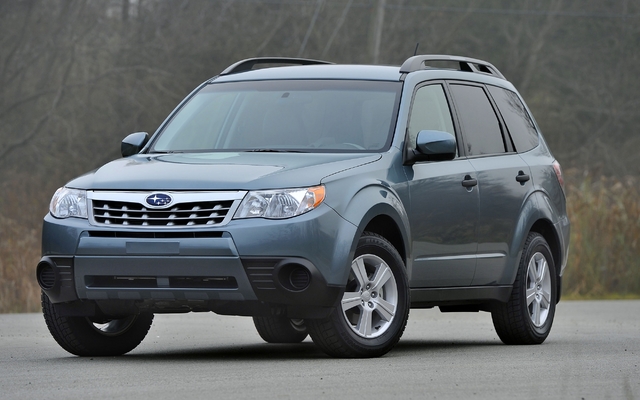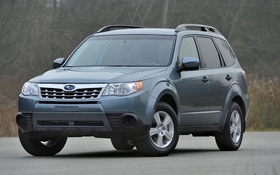2011 Subaru Forester – Intelligently updated

| Strong points |
|
|---|---|
| Weak points |
|
Just as software companies offer updates for the programs installed on your computer, Subaru has recently made some mechanical upgrades and interior improvements to its Forester SUV. Why put the new generation of the horizontal engine in this model? No doubt it’s because the Forester, despite its popularity, needed a boost to stand out from the Outback, which is now an entity unto itself and not merely a Legacy wagon disguised as a crossover.
To attract potential buyers, Subaru management has equipped the 2011 Forester with an all-new engine, in addition to updating the equipment level for the different trim levels.
Once a Boxer, always a Boxer
Never make the mistake of asking a Subaru engineer, or even a Subaru car owner, why they insist on using horizontal-cylinder engines – or Boxers – under the hood of the vehicles built by Fuji Heavy Industries, Subaru’s manufacturing company. You’ll need a lot of patience to sit through the ensuing explanation about all the advantages of this configuration. There’s the lower centre of gravity, lack of vibrations, the extremely compact engine block, to name just a few. And of course they’ll add the fact, and with good reason, that this exceptionally thin engine will slide under the car in the case of a head-on collision, thereby sparing passengers from an engine busting into the passenger compartment. Incidentally, the Forester, like all Subaru vehicles, has excellent front and side safety ratings.
For 2011, Subaru engineers decided to upgrade their essential 2.5-litre four-cylinder engine. They didn’t necessarily make it more powerful, as its horsepower remains unchanged at 170. Torque has increased from 170 lbs-ft to 174. So you might find yourself thinking that the upgrade offers little advantage and they might as well have kept the old version. But the modifications, which include lengthening the piston stroke and reducing cylinder diameter, reduce vibrations, allow for a more compact combustion chamber and optimize fuel combustion. Like on the previous version, this engine is paired factory-standard with a five-speed manual gearbox, and a six-speed automatic is available on option.
One detail worth mentioning is that the manual and automatic versions get different all-wheel drive systems (AWD being standard on all Subaru vehicles). On manual versions, the engineers called on viscous coupling to lock the central differential and split the power 50/50. If you opt for the automatic, the clutch system is an electronic transfer gearbox with multiple discs to manage the distribution of power 60/40.
More homogenous
Logically, you may think that these modifications would have little impact on the vehicle’s handling and performances. True, the engine output has not gone from black to while, but, nonetheless, this drive train is markedly more homogenous than the one it is replacing. The numbers say it all. Indeed, the previous engine was often left huffing and puffing in certain conditions. When passing or climbing uphill, you got the feeling it had trouble keeping up. Nothing major, but it was noticeable.
This time around, the four-cylinder engine consistently seemed up to the task. When the 2011 Forester was presented in the Quebec City area, we had the chance to take the automatic version for a 200 km spin. To me, the new Boxer engine seemed more flexible and homogenous, and its purr was more pleasant. I know that the sound is just a small detail, but you have to remember that Subaru engines, robust as they were, suffered from a tinny sound for years. As they have evolved, this annoying noise has disappeared. Despite everything, though, the characteristic sound of a Boxer engine will never disappear.
As for the rest of the vehicle, it hasn’t changed or aged since its last update a few years back. The quality of the assembly and materials is impeccable, while the comfort offered in the passenger compartment is good. The excellent rear visibility is most appreciated when backing up. No surprises in terms of road handing, and the AWD proved effective on the roads around the Quebec capital. On several occasions during our test drive, the lateral stability system kicked in, allowing me to appreciate its skills. In short, the Forester has earned better points for homogeneity, and if you think the 170 horses delivered by its naturally aspirated engine are insufficient, you can always opt for the 2.5XT Limited, which is equipped with a 224-hp turbocharged engine.
In addition to the new engine, the marketing directors revamped the options packages. Buyers can now choose the Convenience Package or the Touring Package. Of course, the Limited versions are the most luxurious of them all. These include the 2.5X Limited with its 170-hp engine and the 2.5XT with the turbo. In both cases, the only gearbox available is the automatic four-speed.
Conclusion: the improvements made to the Forester with a naturally aspirated engine are not spectacular, but they add to the vehicle’s homogeneity and driving pleasure.











